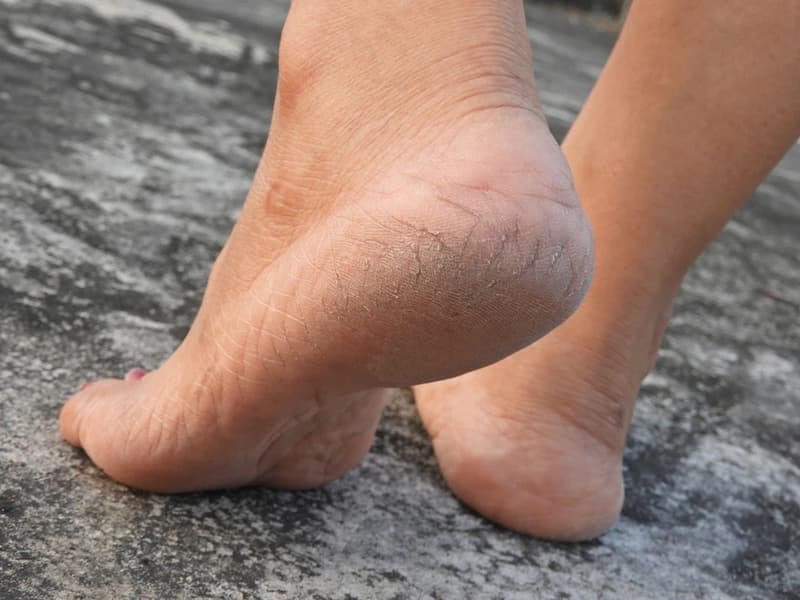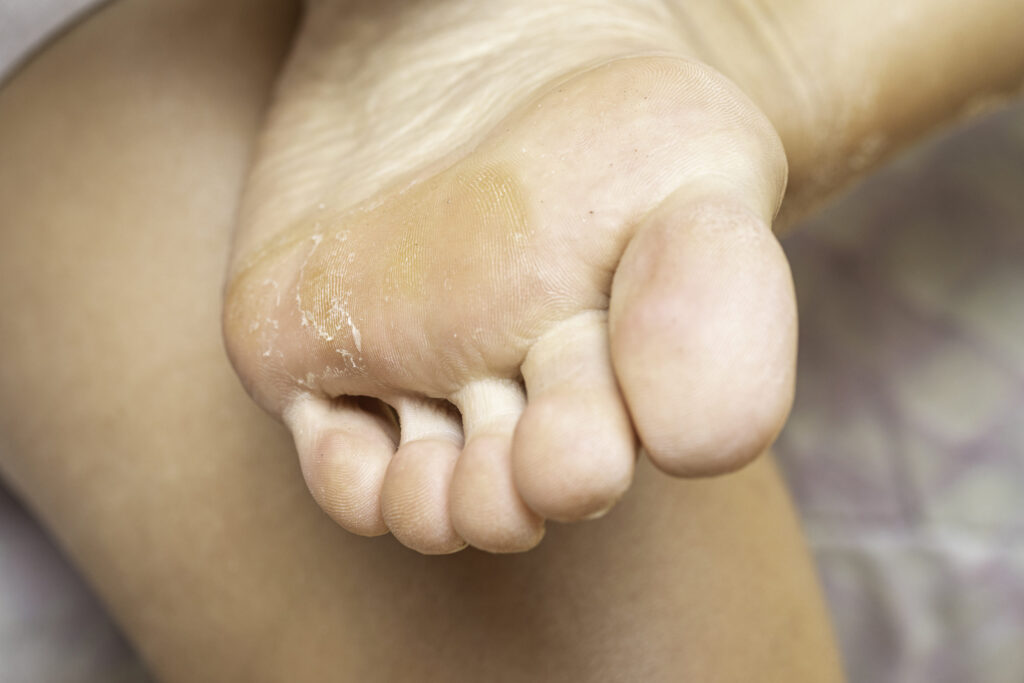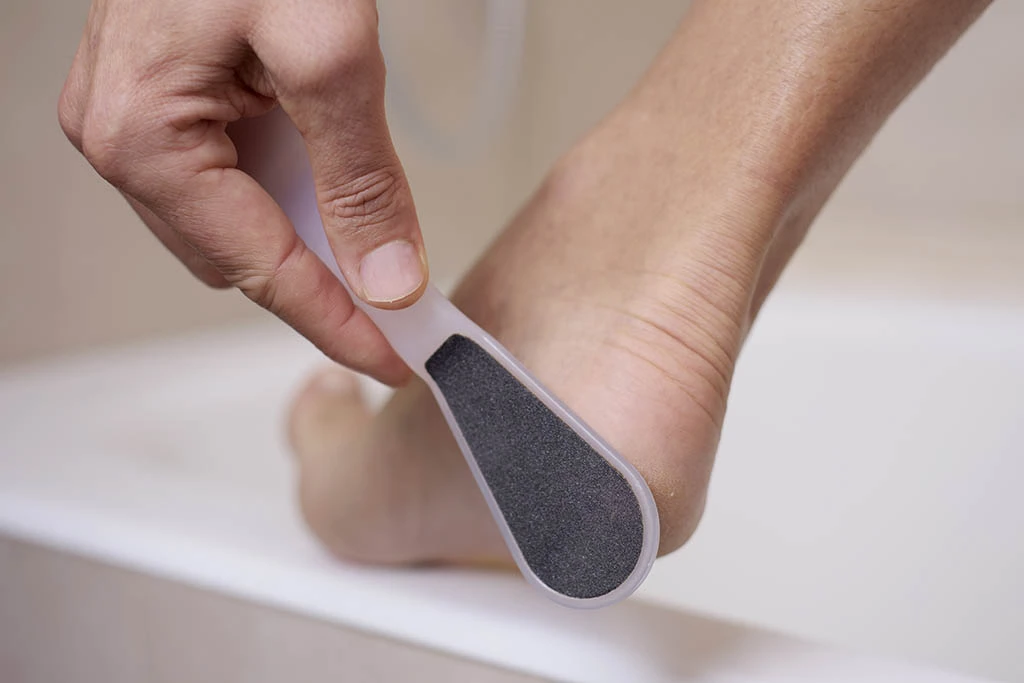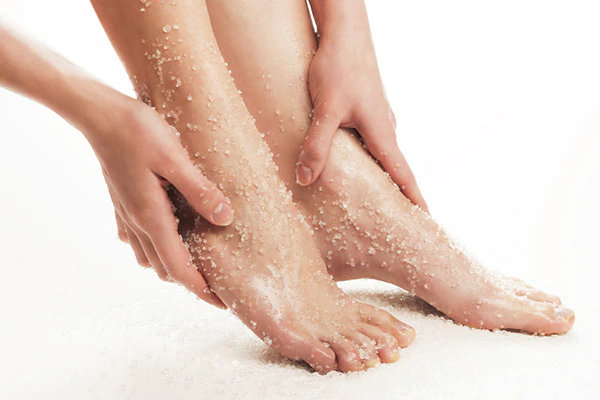How to Remove Dead Skin From Feet

Are your feet going to be dry this winter? Dead skin buildup on the feet is a common podiatry problem, especially during the colder months. Dead skin can develop on the soles of the feet, leading to excessive drying and cracking of the feet. Dead skin can be painful if it’s caused by eczema, athlete’s foot, or other serious infection.
In this article, we’ll discuss some of the most effective ways to remove thick layers of dead skin.
Table of Contents
Causes of Dead Skin on Feet

Dead skin buildup is closely related to dryness. Many internal and external factors can affect the skin of the feet, resulting in excessive skin necrosis.
Common causes of dry feet and dead skin buildup include:
Weather – As the season’s change, our skin can react negatively. Cold weather can cause dry skin on the feet.
Diabetes – Diabetes can cause changes in the skin of your feet. Sometimes your feet can become very dry. The skin may peel and crack. The problem is that the nerves that control oil and moisture in your feet no longer work.
Calluses – Calluses build up on feet when they are subjected to high pressure or friction from footwear, sports, or everyday activities.
Showering – The main causes of dry skin are excessive bathing and soap dermatitis. Soap removes the skin’s natural protective oils. Once they are gone, the skin cannot retain moisture.
Age and Hormones – Due to changes within the body, the skin, including the skin on the feet, may experience dryness.
Skin Conditions – Patients with skin conditions such as eczema are more likely to experience dryness and dead skin buildup on the feet.
Everyone’s feet shed dead skin. It is a natural function of the human body. However, if you have the excess dead skin on your feet, see a podiatrist. Your podiatrist will examine the skin condition of your feet and evaluate for potential causes that require medical attention.
Removing Dead Skin From Your Feet

Foot Soaks
Foot baths are truly a relaxing part of foot care; they not only rejuvenate the feet but also relax the mind and body. Soaking your feet in hot water, infused with essential oils and skin softeners, can make your feet feel relaxed and clear your mind.
If you find it challenging to find time in your busy schedule for foot care, this is a remedy that requires very little effort on your part. You’ll need to fill a footbath or footbath with warm water and pour in some essential oils that have skin-softening properties. Coconut oil, tea tree oil, lavender oil, and argan oil are all good choices.
Warm water penetrates deep into cracked heels, restoring moisture, moisturizing skin cells, and loosening dead skin cells. Then, you can use a pumice stone or a file to remove the thick layer that peels off easily.
Pumice Stone
Pumice stones are one of the most effective foot care tools to add to your daily skincare regime. It is a stone made of natural lava. A high-quality pumice stone, such as those from love Lori, is essential for foot care. It helps remove dead skin and calluses while treating athletes’ feet and other infections.
In order to use pumice, you need to soak your feet in hot or lukewarm water. Start by soaking your feet in warm water for at least 10 minutes; this is important to soften dead skin so it’s easy to peel off.
Then, start moving the stone laterally or circularly across your feet to gently exfoliate the dead skin. It’s best to keep soaking the pumice stone in warm water, as this helps simplify the process. Don’t be too ambitious when removing thicker layers and larger patches. Instead, concentrate on getting rid of the top layer and gradually move towards the entire area.
If you remove an entire piece of dead skin, it can cause bleeding, and bruising, and can affect the renewal of healthy cells. When you’re done, be sure to apply some tea tree oil or your regular foot cream to soften your feet. If you have any injuries or pain, avoid using pumice stones in the area.
Dead skin layers from infections, such as athlete’s foot, are slightly different and more severe. Because they can be painful and cause serious infections, they require more care than most common cosmetic treatments. Consider using a pumice stone for effective results with this tea tree oil and antifungal ingredient.
Paraffin Wax
Paraffin wax is a remarkable remedy for softening hard skin and removing dead skin, and is a popular feature of most high-end pedicures and spa pedicures. Paraffin has a soft consistency that melts paraffin at moderate temperatures.
Paraffin treatment for your feet at home is easy. You’ll need to prepare a paraffin foot bath, or you can take the simpler approach and melt the wax in a pan. Once it’s melted, place it in a bowl or tub so you can comfortably dip your feet. You have to dip your feet in paraffin several times to make sure every inch is adequately covered.
Be sure to avoid hot wax on your feet as it can leave burn marks and cause irritation. If you’re not sure about the temperature, do a small patch test or use a candy thermometer for accuracy. Once you’ve got a few coats of wax on your feet, grab some plastic wrap to wrap your feet. The wax will harden and you can easily remove it. When you remove the wax, the dead skin also naturally sloughs off, leaving a naturally soft feel.
If you have low blood circulation, open sores, bruises, or rashes on your feet, it’s best to avoid paraffin wax. People who suffer from loss of sensation in the feet, such as those with diabetic neuropathy, are also advised not to use paraffin.
Foot Scrubs
Removing tough skin and layers of aging dead cells can prove difficult and painful, which is why maintaining foot care in your skincare routine is crucial. Foot scrubs are an easy way to prevent the appearance of dry patches of skin and repair damaged skin in a consistent and effective way.
You can choose any of the over-the-counter foot scrubs that feature the ability to heal cracked skin and remove dead skin from the skin. It’s best to invest in a foot massager, scrubber, and cleanser, as it makes the process incredibly easy and rewarding. Scrubs will become an integral part of your daily foot care and shower rituals.
If you like natural homemade scrubs, there are many remedies and natural ingredients that can effectively soften tough skin and get rid of dead skin and calluses. The easiest way to make your own scrub is to mix two tablespoons of sea salt with baby oil and lemon juice. Apply the scrub too hard, dry feet, rubbing lightly with the palm of your hand. If you’re dealing with tough dead skin layers and overly dry feet, it’s best to use a scrubber.
Oatmeal scrub is a commonly used traditional remedy to exfoliate the skin from the deep end to remove dry skin. You can make your own oatmeal scrub at home by mixing oatmeal with some milk and rose water. For effective results, apply the oatmeal scrub to your feet and let it work its magic for at least half an hour. Then, use a foot file, pumice stone, or foot brush to exfoliate your feet to peel away layers of dead skin.
When you’re done, consider soaking your feet in hot water to rinse off excess water. Be sure to apply a moisturizer or a good antifungal foot cream after your feet dry.
Baby Foot Peels
Peeling feet Peels are a symptom of excessive dryness, neglect of foot care, athlete’s foot, or serious infections such as eczema and psoriasis. Baby Foot Peeling is one of the most common foot care methods at home to remove dead skin cells and restore smooth and soft feet.
Baby foot leather comes with plastic boots and needs to be applied to the feet for at least an hour for effective results. These boots contain a gel-like liquid solution that includes skin softeners, moisturizers, and fruit acids to help exfoliate dead skin and restore smooth feet.
Start by soaking your feet, then attach the plastic boots to your feet with adhesive. Allow the boots to work their magic for at least an hour before taking off the boots and washing your feet with soap. It’s vital to soak your feet regularly to promote peeling and ensure dead skin layers are removed within a week or less.
This therapy may have no scientific basis, but it has overwhelming support around the world as many swear by its efficacy and effectiveness in eliminating dead skin cells.
Vinegar
Vinegar is another popular traditional remedy that has been synonymous with foot care for centuries. Vinegar prevents dryness, helps remove dead skin layers, and heals dry, cracked heels.
Not only can a vinegar soak help you relax after a tiring day at work, but it also softens your feet and makes it easier to remove dry, dead, and cracked skin. You can use any vinegar you like; white and apple cider vinegar is the most popular choices, and people usually stock them in the kitchen.
It is important to prepare your vinegar soak with cold water. Hot water will speed up the drying process and do more harm than good. Add 2 parts water to 1 part vinegar and soak your feet for at least 10 minutes.
Then, use a pumice stone or foot file to remove sagging skin or dry patches. When you’re done, apply some coconut oil or foot cream to moisturize your skin, then wear a pair of thick socks to lock in the moisture from the vinegar soak.
It is best to repeat this treatment no more than two to three times a week, as multiple repetitions can lead to more dryness.
Epsom Salts
Magnesium sulfate is a mineral compound in crystalline form, and Epsom salt has many health and skin benefits. Epsom salts are an excellent ingredient to exfoliate dry and dead skin and restore smoothness to your feet. You can do an Epsom salt scrub or even a foot soak.
When soaking your feet, dissolve two tablespoons of Epsom salts in a foot bath with warm water. Soak your feet for at least 20 minutes and enjoy an effective exfoliation for dry and cracked feet. After an exhausting day, you can dissolve a cup of Epsom salts in a tub filled with warm water to prevent dryness and relax.
When you’re done, be sure to use a pumice stone or foot brush to remove dry and dead skin layers.
You can make an Epsom salt scrub by mixing some salt with olive oil, coconut oil, or even hot water. Apply the scrub to your feet with a sponge, rubbing gently to exfoliate and remove dead skin. Be sure to wet your feet before applying the scrub, and moisturize your feet after you’re done to prevent dryness.
How to Prevent Dry Feet

Moisturizing your feet regularly is key to preventing the excess buildup of dead skin.
To combat dry skin, moisturize your feet regularly. Moisturizers act as a seal on your skin, preventing moisture from escaping and preventing dry skin. Moisturize as much as you can, especially before going to bed. Then put on socks and lock in moisture overnight.
Caring for your feet by soaking, exfoliating, and moisturizing can improve their appearance and promote good foot health.
Conclusion
Once you’ve removed the thick layer of dead skin with any of the above home remedies or treatments, keep in mind that your feet will need regular care and nourishment. Foot care must be a consistent and integral part of your daily self-grooming and cleansing ritual.
If you start ignoring your foot care needs again, dry and dead skin cells can quickly return. Consider investing in some foot wipes, scrubbers, foot creams, pumice stones, and other tools to help you maintain a vigilant and simple foot care regime that doesn’t require much effort or time. Adding essential oils, such as tea tree oil and coconut oil, to your foot care regime can also make a big difference in their maintenance.
Be sure to keep your feet wet and be careful when choosing a shoe. If you always wear closed shoes, high heels, and heavy socks, consider alternating open-toe and slingback designs to allow your feet to breathe. Dehydration and dampness can wreak havoc on our skin as they lead to dry, dead skin and more serious skin problems like eczema and psoriasis.
Tags: Dead Skin, Feet Dead Skin